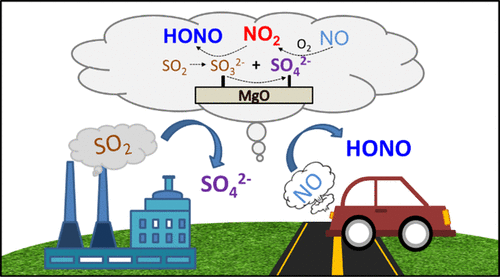当前位置:
X-MOL 学术
›
Environ. Sci. Technol.
›
论文详情
Our official English website, www.x-mol.net, welcomes your
feedback! (Note: you will need to create a separate account there.)
Efficient Conversion of NO to NO2 on SO2-Aged MgO under Atmospheric Conditions.
Environmental Science & Technology ( IF 10.8 ) Pub Date : 2020-09-04 , DOI: 10.1021/acs.est.0c05071 Chang Liu 1, 2 , Honghong Wang 3, 4 , Qingxin Ma 2, 3, 4, 5 , Jinzhu Ma 3, 4, 5 , Zhe Wang 6 , Linlin Liang 1 , Wanyun Xu 1 , Gen Zhang 1 , Xiaoye Zhang 1, 4 , Tao Wang 2 , Hong He 3, 4, 5
Environmental Science & Technology ( IF 10.8 ) Pub Date : 2020-09-04 , DOI: 10.1021/acs.est.0c05071 Chang Liu 1, 2 , Honghong Wang 3, 4 , Qingxin Ma 2, 3, 4, 5 , Jinzhu Ma 3, 4, 5 , Zhe Wang 6 , Linlin Liang 1 , Wanyun Xu 1 , Gen Zhang 1 , Xiaoye Zhang 1, 4 , Tao Wang 2 , Hong He 3, 4, 5
Affiliation

|
The NO–NO2 cycle determines the formation of O3 and hence plays a critical role in the oxidizing capacity of troposphere. Traditional view concluded that the heterogeneous oxidation of NO to NO2 was negligible due to the weak reactivity of NO on aerosols, compared to the homogeneous oxidation process. However, the results here reported for the first time that SO2 can greatly promote the heterogeneous transformation of NO into NO2 and HONO on MgO particles under ambient conditions. The uptake coefficients of NO were increased by 2–3 orders of magnitudes on SO2-aged MgO, compared to the fresh sample. Based on spectroscopic characterization and density functional theory (DFT) calculations, the active sites for the adsorption and oxidation of NO were determined to be sulfates, where an intermediate [SO4–NO] complex was formed during the adsorption. The decomposition of this species led to the formation of NO2 and the change of sulfate configuration. The formed NO2 could further react with surface sulfite to form HONO and sulfate. The conversion of NO to NO2 and HONO on the SO2-aged MgO surface under ambient conditions contributes a new formation pathway of NO2 and HONO and could be quite helpful for understanding the source of atmospheric oxidizing capacity as well as the formation of air pollution complexes in polluted regions such as the northern China.
更新日期:2020-10-06











































 京公网安备 11010802027423号
京公网安备 11010802027423号